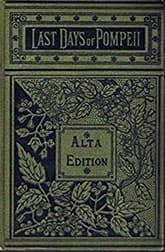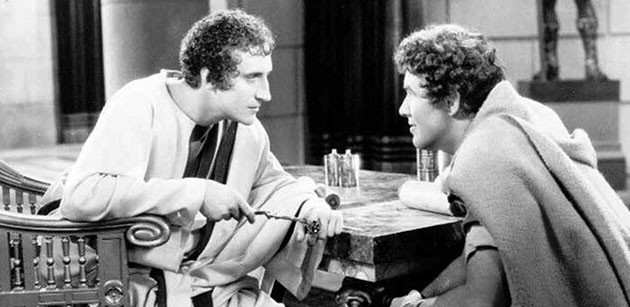The Last Days of Pompeii
Critique • Quotes • At the movies
 1851 Alta edition
1851 Alta editionFirst publication
1934
Literary form
Novel
Genres
Literary, historical fiction
Writing language
English
Author's country
England
Length
Approx. 158,500 words

Pontius Pilate (Basil Rathbone) and former gladiator Marcus (Preston Foster) confer in 1935 film.
Some other last days
The Last Days of Pompeii (1935): Film, 96 minutes; director Ernest B. Schoedsack; writer Ruth Rose; story by James Ashmore Creelman, Melvin Baker; featuring Preston Foster, Basil Rathbone, David Holt, Alan Hale, John Wood, Dorothy Wilson
Producers of the 1935 film entitled The Last Days of Pompeii were quite open about their film not being an adaptation of Edward Bulwer-Lytton's novel of the same name. The only credit given the author in the film's credits are "description of Pompeii which has inspired the physical setting of this picture."
But we can note several other "inspirations." Most prominently, eruption of Vesuvius and the resulting destruction of the city and terror of its people. The volcano occurs, as in the original story, just as gladiatorial contests are about to take place in the local arena.
There's also a religious theme to the film, as in the novel, but it is unrecognizable. In place of Bulwer-Lytton's questioned and nuanced theology, this film goes whole hog Christian. The Roman material is married to the New Testament narrative, placing it in that Hollywood tradition of such book-derived Roman-Christian morality tales as Ben Hur, The Robe and Quo Vadis. Jesus Christ appears as a healer to the son of our main character Marcus (Preston Foster in one of his earliest roles), a kindly smith, who replaces the novel's protagonist Glaucus. And later Jesus is the Biblical prisoner condemned by Pontius Pilate (Basil Rathbone, of later Sherlock Holmes fame). In fact, in place of the book's villainous Egyptian priest Arbaces, Pilate takes a central role in film. Unlike Arbaces, however, he is a conflicted figure.
And there is a slave girl in an ill-fated love affair with the main character, though this is played down to the point that she's practically forgotten. Her final sacrifice to help the others escape Pompeii is eliminated and Marcus performs that function, expiring in a blaze of religious fervour.
Vesuvius erupts in 1935 film The Last Days of Pompeii.
The rest of the story from beginning to end is quite different from the book or from other movies purportedly inspired by it.
Apart from the destruction of Pompeii scenes, the greatest value of this film may be—by way of contrast—to make the original novel appear greater.
— Eric
Critique • Quotes • At the movies
1913, 1935

